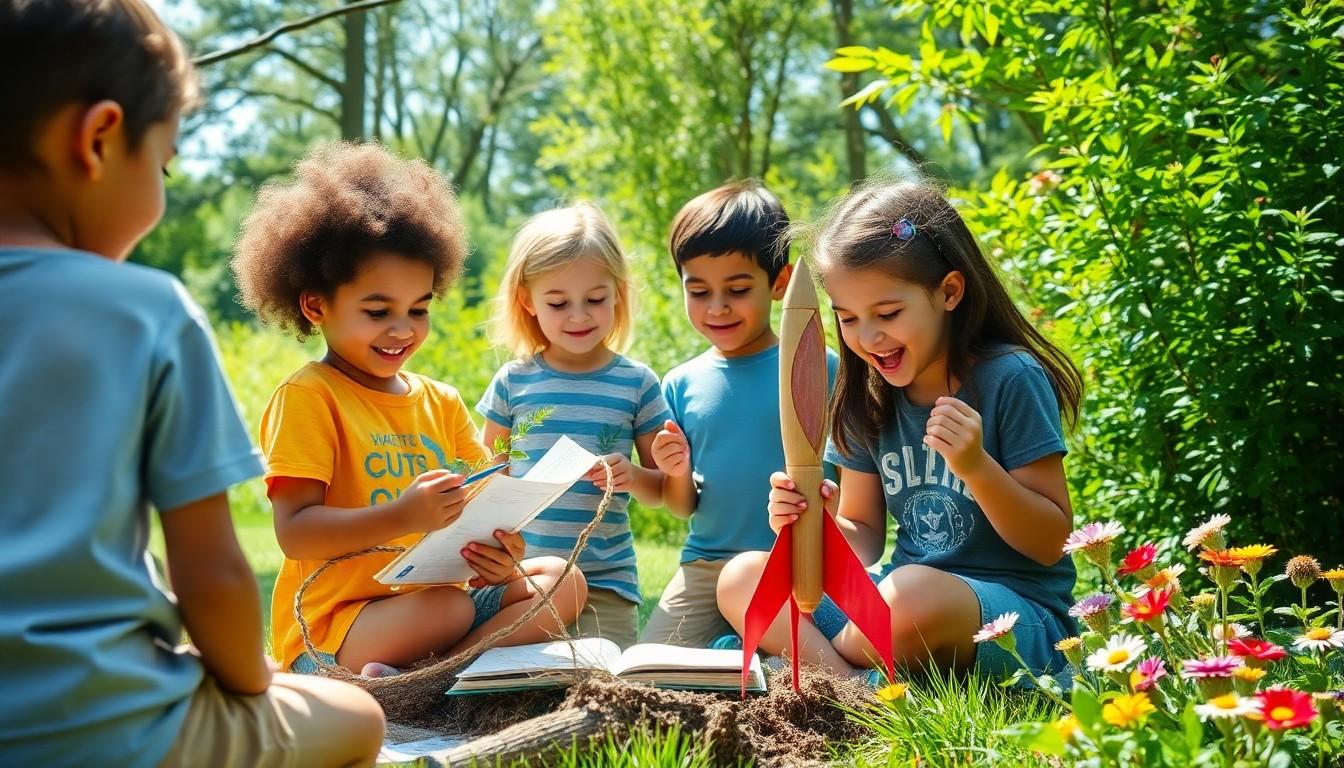Imagine a world where kids trade their screens for sunshine and science. Outdoor STEM activities offer the perfect blend of fun and learning, transforming any backyard into a bustling laboratory. Whether it’s building a rocket from recycled materials or conducting a nature scavenger hunt, these activities spark curiosity and ignite a passion for exploration.
Outdoor STEM Activities
Outdoor STEM activities provide hands-on learning experiences that foster curiosity and a love for exploration. Building rockets from recycled materials encourages creativity and problem-solving skills. Nature scavenger hunts engage children in their surroundings, enhancing observational skills and environmental awareness.
Conducting experiments in nature helps kids understand scientific concepts in real-world contexts. For instance, measuring rainfall with simple tools teaches them about weather patterns. Engaging in gardening activities introduces biology and ecology principles while promoting responsibility and teamwork.
Incorporating technology, like using cameras for documenting wildlife, allows children to explore biology through photography. Participating in bird watching can spark interest in species identification and habitats, linking science to outdoor experiences. Creating simple machines with found objects emphasizes engineering principles and critical thinking.
Exploring physics through activities like tossing a ball to understand motion and force makes learning interactive. Each outdoor activity not only reinforces academic concepts but also improves physical fitness and social skills. Group challenges, such as building a shelter or creating a maze, enhance collaboration and communication.
Children learn to appreciate nature while developing essential skills through these immersive experiences. In summary, outdoor STEM activities serve as vital tools for comprehensive education, allowing children to connect academic knowledge with the environment.
Benefits of Outdoor STEM Activities

Outdoor STEM activities significantly enhance children’s learning experiences and provide numerous advantages. Engaging with nature while learning boosts curiosity and fosters creativity.
Encouraging Creativity
Outdoor STEM activities spark imaginative thinking in children. Building structures from found materials encourages innovative problem-solving. Activities like designing and launching rockets or creating art with natural elements allow kids to express their ideas freely. Nature journaling, for example, invites them to sketch local flora and fauna, combining art with scientific observation. Engaging in these hands-on activities cultivates a mindset oriented towards experimentation and exploration.
Promoting Physical Health
Participating in outdoor STEM activities promotes physical health among children. Active engagement with projects like gardening or scavenger hunts keeps them moving and develops motor skills. These activities often occur in natural settings, encouraging children to enjoy fresh air and sunlight. Regular outdoor play reduces screen time and supports mental well-being, which is essential for their overall development. As children climb, run, and explore, they build strength and resilience, creating a foundation for lifelong physical fitness.
Types of Outdoor STEM Activities
Outdoor STEM activities encompass various engaging experiences that enhance children’s learning. These activities provide hands-on opportunities to explore and interact with the natural world.
Nature Exploration
Nature exploration activities can ignite children’s curiosity about their environment. Scavenger hunts encourage them to search for specific plants or animal tracks, enhancing observation skills. Identifying different species fosters a deeper understanding of biodiversity. Activities like collecting leaves for categorization promote critical thinking and data analysis. Tracking weather patterns through outdoor observations presents real-world applications for scientific principles. Engaging in habitat studies allows children to grasp ecological balance. Such experiences cultivate appreciation for nature while reinforcing scientific concepts in memorable ways.
Gardening Projects
Gardening projects serve as effective outdoor STEM activities that integrate biology and environmental science. Creating a small garden allows children to witness the growth cycle of plants firsthand. Planting seeds and observing their development offers insights into photosynthesis and soil health. A composting project teaches children sustainable practices, demonstrating waste reduction and nutrient recycling. Integrating measurements of growth encourages mathematical reasoning. Children can also explore the connections between plant health and weather conditions. Involving them in cooking with garden produce enhances the understanding of nutrition and food sources. These projects ground abstract concepts in tangible experiences.
Engaging Kids in Outdoor STEM Activities
Outdoor STEM activities offer children hands-on learning in a vibrant, engaging environment. These experiences enrich their understanding of various scientific concepts.
Preparing for Activities
Preparation sets the stage for successful outdoor STEM activities. Gathering necessary materials enhances engagement and fosters creativity. For example, collecting items for recycling projects can spark innovative ideas. Setting clear objectives guides the activities, ensuring focused learning. Additionally, scouting locations in advance identifies the best spots for exploration. Providing age-appropriate tasks guarantees all children can participate effectively. Planning schedules helps manage time efficiently, ensuring activities run smoothly. Involving kids in the planning phase motivates them and boosts their enthusiasm for the projects.
Ensuring Safety
Safety ensures children enjoy outdoor STEM activities without risks. Assessing the environment before starting activities minimizes hazards. Checking for insects, uneven ground, or other dangers requires careful attention. Explaining safety rules clearly helps kids understand expectations. Providing supervision during activities is critical, especially in larger groups. Encouraging children to wear appropriate clothing protects them from the elements. First aid kits should be readily available for minor injuries. Communicating with parents about safety measures fosters trust and support. By prioritizing safety, outdoor STEM experiences become enjoyable and secure for all participants.
Merging Education with Nature
Outdoor STEM activities play a crucial role in children’s development by merging education with nature. Through hands-on experiences they not only learn scientific concepts but also cultivate a sense of wonder and curiosity. Engaging in these activities promotes physical health and mental well-being while fostering creativity and critical thinking skills.
By encouraging exploration and collaboration kids gain practical knowledge that extends beyond the classroom. As they build rockets or embark on scavenger hunts they develop a deeper appreciation for the environment. These enriching experiences lay the groundwork for lifelong learning and a genuine connection to the natural world. Embracing outdoor STEM activities can truly transform the way children engage with science and the environment around them.




